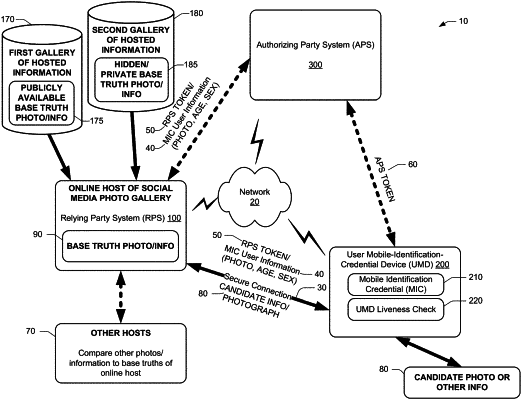| CPC G06F 21/32 (2013.01) [G06V 10/40 (2022.01); H04L 9/0825 (2013.01); H04L 9/3213 (2013.01); H04L 9/3247 (2013.01); H04L 63/0823 (2013.01); G06F 2221/2133 (2013.01)] | 28 Claims |

|
1. An apparatus, for an online host to verify information of a user, comprising:
a processing system having a hardware processor configured to perform a predefined set of basic operations by loading corresponding ones of a predefined native instruction set of codes, the predefined native instruction set of codes constituting a set of instructions selectable for execution by the hardware processor;
a memory accessible to the processing system;
a communication controller, under control of the processing system;
engagement logic, stored in the memory, comprising a first respective sequence of instructions selected from the predefined native instruction set of codes of the hardware processor and adapted to establish a secure connection with a user mobile-identification-credential device (UMD), having a mobile identification credential (MIC) associated with official information, via the communication controller;
information request logic, stored in the memory, comprising a second respective sequence of instructions selected from the predefined native instruction set of codes of the hardware processor and adapted to send the UMD a MIC user information request message, seeking the official information associated with the MIC, over the secure connection;
verification logic, stored in the memory, comprising a third respective sequence of instructions selected from the predefined native instruction set of codes of the hardware processor and adapted to send an authorizing party system (APS) a token received from the UMD;
APS verification logic, stored in the memory, comprising a fourth respective sequence of instructions selected from the predefined native instruction set of codes of the hardware processor and adapted to receive the official information and to cryptographically verify the official information; and
the memory further storing instructions, selected from the predefined native instruction set of codes, defining logic adapted to:
obtain, by the online host serving as a relying party system (RPS), verification of the official information received from the UMD having the MIC, in response to the RPS sending the UMD the MIC user information request message;
store, by the RPS, the official information as hosted information pertaining to the user;
designate, by the RPS, the hosted information as base truth information representing the user;
identify, by the RPS, user-designated hosted information;
compare the user-designated hosted information to the base truth information; and
responsive to the user-designated hosted information matching the base truth information to within a match threshold, designate the user-designated hosted information as trustworthy and genuinely representing the user.
|